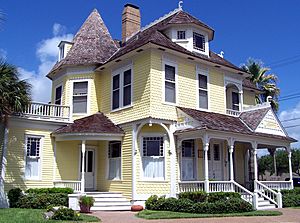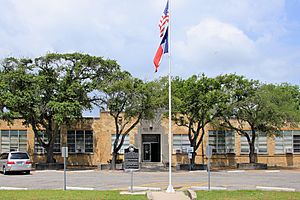Rockport, Texas facts for kids
Quick facts for kids
Rockport, Texas
|
||
|---|---|---|
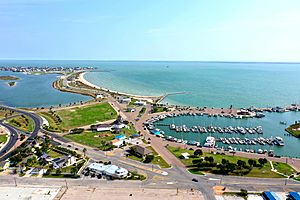 |
||
|
||
| Nickname(s):
The Texas Riviera
|
||
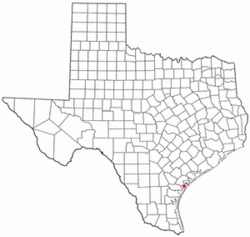
Location of Rockport, Texas
|
||
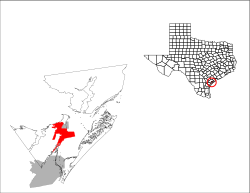 |
||
| Country | United States | |
| State | Texas | |
| County | Aransas | |
| Incorporated | August 18, 1870 | |
| Area | ||
| • Total | 21.09 sq mi (54.63 km2) | |
| • Land | 16.55 sq mi (42.85 km2) | |
| • Water | 4.55 sq mi (11.78 km2) | |
| Elevation | 7 ft (2 m) | |
| Population
(2020)
|
||
| • Total | 10,070 | |
| • Estimate
(2021)
|
10,436 | |
| • Density | 477.5/sq mi (184.33/km2) | |
| Time zone | UTC-6 (Central (CST)) | |
| • Summer (DST) | UTC-5 (CDT) | |
| ZIP codes |
78381-78382
|
|
| Area code(s) | 361 | |
| FIPS code | 48-62804 | |
| GNIS feature ID | 1345420 | |
Rockport is a city in Texas, United States. It is the main city of Aransas County. In 2020, about 10,070 people lived there.
Rockport is right next to the town of Fulton. Many people call them "Rockport-Fulton" together. But remember, Rockport and Fulton are actually two separate cities.
Contents
History of Rockport
How Rockport Started
After the Civil War, people wanted to build new towns. In 1867, Joseph F. Smith, Thomas H. Mathis, and J.M. Mathis built a wharf (a place for ships to dock) where Rockport is now. George W. Fulton and his wife, Harriet Smith Fulton, also moved to the area. They helped develop Rockport and also started the town of Fulton nearby.
A business that processed cattle quickly grew around the wharf. Because of this growth, Rockport officially became a town in 1870. It was named Rockport because of the rocky edge along the shore. Thomas Mathis became the first mayor. By 1871, the town had grown so much that it became a "city."
Growth and Challenges
In 1871, the Mathis cousins, George W. Fulton, and Thomas M. Coleman worked together. They raised and processed cattle to send out from the city's wharf by steamship. This partnership was very successful and brought more people and businesses to Rockport.
However, a big economic problem called the Panic of 1873 slowed things down for a few years. The cattle business struggled, and the Mathis cousins left the partnership in 1879. Fulton and Coleman continued their ranching business until the 1930s.
For many years, people like Fulton wanted a railroad to come to Rockport. This would give them another way to transport goods and break the steamship company's control. Finally, in 1888, the railroad arrived! This brought new growth, but it was short-lived.
The railroad did bring tourists, and Rockport's economy started to focus on shipbuilding and tourism by the end of the 1800s.
20th Century Changes
Rockport faced more challenges in the early 1900s. A huge hurricane hit the area in 1919, causing a lot of damage. Recovery was slow.
Things started to get better in 1925 when a successful shrimping industry began. This industry grew even more in the 1930s, especially after a new harbor was built in 1935. Shrimping slowed down during World War II but picked up again afterward. A boat-building industry also became important around this time. By the end of the century, shrimping, fishing, and tourism were key parts of Rockport's economy.
Recent Times
On August 25, 2017, Hurricane Harvey hit Rockport as a very strong storm. It caused a lot of damage. Many buildings were badly hurt or destroyed. The city's courthouse was damaged, and the high school lost walls. Many homes and businesses were also damaged. Airplanes at the local airport were destroyed. About 20% of Rockport's people had to leave their homes and could not return for a year. The community has been working hard to rebuild and recover.
Rockport's Location and Weather
Where is Rockport?
Rockport is located on the Live Oak Peninsula. This land area separates Aransas Bay (which is part of the Gulf of Mexico) from Copano Bay. The city covers about 47.9 square kilometers (18.5 square miles). Most of this is land, but about 11.8 square kilometers (4.55 square miles) is water.
Rockport's Climate
The weather in Rockport has hot, humid summers. Winters are usually mild or cool. Rockport has a humid subtropical climate. This means it gets a lot of rain, and the temperatures are generally warm.
| Climate data for Rockport, Texas (1981–2010 normals, extremes 1959–2013, 2023–present) | |||||||||||||
|---|---|---|---|---|---|---|---|---|---|---|---|---|---|
| Month | Jan | Feb | Mar | Apr | May | Jun | Jul | Aug | Sep | Oct | Nov | Dec | Year |
| Record high °F (°C) | 87 (31) |
90 (32) |
99 (37) |
100 (38) |
98 (37) |
102 (39) |
100 (38) |
102 (39) |
105 (41) |
97 (36) |
96 (36) |
87 (31) |
105 (41) |
| Mean daily maximum °F (°C) | 65.2 (18.4) |
67.2 (19.6) |
72.6 (22.6) |
78.8 (26.0) |
84.5 (29.2) |
89.8 (32.1) |
91.6 (33.1) |
92.5 (33.6) |
90.1 (32.3) |
83.7 (28.7) |
75.3 (24.1) |
67.5 (19.7) |
80.0 (26.7) |
| Daily mean °F (°C) | 55.6 (13.1) |
58.3 (14.6) |
64.2 (17.9) |
71.7 (22.1) |
78.4 (25.8) |
83.5 (28.6) |
85.3 (29.6) |
85.6 (29.8) |
82.4 (28.0) |
75.1 (23.9) |
66.1 (18.9) |
57.7 (14.3) |
72.0 (22.2) |
| Mean daily minimum °F (°C) | 46.0 (7.8) |
49.3 (9.6) |
55.8 (13.2) |
64.5 (18.1) |
72.3 (22.4) |
77.3 (25.2) |
79.1 (26.2) |
78.7 (25.9) |
74.7 (23.7) |
66.5 (19.2) |
57.0 (13.9) |
47.8 (8.8) |
64.1 (17.8) |
| Record low °F (°C) | 14 (−10) |
22 (−6) |
23 (−5) |
38 (3) |
48 (9) |
57 (14) |
64 (18) |
64 (18) |
50 (10) |
29 (−2) |
27 (−3) |
12 (−11) |
12 (−11) |
| Average precipitation inches (mm) | 2.42 (61) |
2.20 (56) |
2.40 (61) |
1.76 (45) |
3.10 (79) |
3.17 (81) |
3.46 (88) |
2.57 (65) |
5.08 (129) |
4.22 (107) |
3.02 (77) |
1.78 (45) |
35.18 (894) |
| Average snowfall inches (cm) | 0.0 (0.0) |
0.0 (0.0) |
0.0 (0.0) |
0.0 (0.0) |
0.0 (0.0) |
0.0 (0.0) |
0.0 (0.0) |
0.0 (0.0) |
0.0 (0.0) |
0.0 (0.0) |
0.0 (0.0) |
0.2 (0.51) |
0.2 (0.51) |
| Average precipitation days (≥ 0.01 in) | 7.3 | 6.8 | 5.5 | 5.1 | 5.3 | 6.1 | 5.5 | 5.6 | 8.7 | 6.5 | 5.7 | 6.5 | 74.6 |
| Average snowy days (≥ 0.1 in) | 0.0 | 0.0 | 0.0 | 0.0 | 0.0 | 0.0 | 0.0 | 0.0 | 0.0 | 0.0 | 0.0 | 0.0 | 0.0 |
| Source: NOAA | |||||||||||||
People of Rockport
| Historical population | |||
|---|---|---|---|
| Census | Pop. | %± | |
| 1890 | 1,069 | — | |
| 1900 | 1,153 | 7.9% | |
| 1910 | 1,382 | 19.9% | |
| 1920 | 1,545 | 11.8% | |
| 1930 | 1,140 | −26.2% | |
| 1940 | 1,729 | 51.7% | |
| 1950 | 2,266 | 31.1% | |
| 1960 | 2,989 | 31.9% | |
| 1970 | 3,879 | 29.8% | |
| 1980 | 3,686 | −5.0% | |
| 1990 | 4,753 | 28.9% | |
| 2000 | 7,385 | 55.4% | |
| 2010 | 8,766 | 18.7% | |
| 2020 | 10,070 | 14.9% | |
| 2021 (est.) | 10,436 | 19.1% | |
| U.S. Decennial Census | |||
In 2020, there were 10,070 people living in Rockport. There were 4,205 households and 2,886 families. Most people in Rockport are White (about 70%). About 21% of the people are Hispanic or Latino. There are also smaller groups of Black, Asian, Native American, and multiracial people.
Fun Things to Do in Rockport
Rockport is a popular place for tourists. People love to visit for fun activities on the water. You can go boating, fishing, duck hunting, waterskiing, swimming, and even birdwatching!
Cool Places to Visit
- Rockport Beach Park: This is the city's biggest public beach. It has a playground and two beach pavilions.
- Historic Sites: You can visit the Fulton Mansion and other historic places.
- Texas Maritime Museum: Learn about the history of ships and the sea in Texas.
- Art Galleries, Restaurants, and Shops: Rockport has many places to explore.
- The Big Tree: This is the oldest live oak tree in Texas! It's on the nearby Lamar Peninsula.
- Boating and Marinas: There are many places to launch boats and find marine services. Key Allegro Marina is a popular spot with canals and homes. Little Bay is a great place for water skiing and jet skiing.
- The Big Blue Crab: This is a giant blue crab sculpture next to Little Bay. It's the world's largest! The original crab was built in the 1950s. It was rebuilt even bigger in 2012 and again in 2021 after Hurricane Harvey. The new crab is designed to be very strong.
Festivals and Events
Rockport hosts many fun events each year:
- Seafair and Wine Festival: These are popular yearly events.
- Rockport Art Festival: Held every year since 1970, this big event happens around the Fourth of July. It features art shows, auctions, and many vendors.
- Rockport Film Festival: This festival has shown and judged movies since 2007.
- Rockport-Fulton Market Days: On the third Saturday and Sunday of every month, vendors from all over Texas come to sell handmade art and crafts. There's live music and food trucks too!
- Pirate Fest: A newer annual festival that celebrates pirates!
Birdwatching Paradise
The area around Rockport is famous for birdwatching. It's on the Central Flyway, a major route for birds migrating across North America.
- Whooping Cranes: These rare birds spend their winters in the nearby Aransas National Wildlife Refuge.
- Bird Sanctuaries: Local groups help protect places like the Connie Hagar sanctuary and Aransas Woods, which are easy to visit.
- Hummer and Birding Expo: Rockport is on the migration route for many hummingbirds. The city hosts an annual expo where you can see hundreds of ruby-throated hummingbirds at feeders.
Schools in Rockport
Most of Rockport is part of the Aransas County Independent School District. The city is home to the Rockport-Fulton High School Pirates. There is also a private school called Sacred Heart School. A small part of Rockport is in the Aransas Pass Independent School District.
Famous People from Rockport
- Ernie Caceres, a musician
- Guy Clark, a country and folk singer and songwriter
- Dat Nguyen, a football player who grew up in Rockport
- George Strait, a famous country singer who also retired in Rockport
- Bill Williams, a game designer and author
See also
 In Spanish: Rockport (Texas) para niños
In Spanish: Rockport (Texas) para niños



